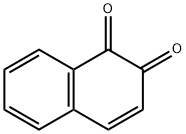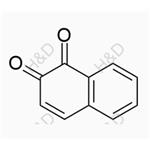Chemical Properties
brown powder
Uses
1,2-Naphthoquinone was employed as mediator during electrochemical mapping of redox activity in normal human breast (MCF-10A) cells by scanning electrochemical microscopy (SECM).
Uses
1,2-Naphthquinone is a highly reactive quinone species which aids in modulating cellular homeostasis and electrophilic signal transduction pathways.
Uses
Chemical reagent and intermediate.
Definition
ChEBI: 1,2-naphthoquinone is the parent structure of the family of 1,2-naphthoquinones, in which the oxo groups of the quinone moiety are at positions 1 and 2 of the naphthalene ring. It is a metabolite of naphthalene and is found in diesel exhaust particles. It has a role as a carcinogenic agent and an aryl hydrocarbon receptor agonist. It derives from a hydride of a naphthalene.
General Description
Golden yellow needles or brown powder. Decomposes to a bluish-black color on standing.
Air & Water Reactions
The neat chemical may be sensitive to prolonged exposure to air and light. Insoluble in water.
Reactivity Profile
Ketones, such as 1,2-NAPHTHOQUINONE, are reactive with many acids and bases liberating heat and flammable gases (e.g., H2). The amount of heat may be sufficient to start a fire in the unreacted portion of the ketone. Ketones react with reducing agents such as hydrides, alkali metals, and nitrides to produce flammable gas (H2) and heat. Ketones are incompatible with isocyanates, aldehydes, cyanides, peroxides, and anhydrides. They react violently with aldehydes, HNO3, HNO3 + H2O2, and HClO4.
Health Hazard
ACUTE/CHRONIC HAZARDS: 1,2-NAPHTHOQUINONE is an irritant. When heated to decomposition it emits acrid smoke and fumes.
Fire Hazard
Flash point data for 1,2-NAPHTHOQUINONE are not available. 1,2-NAPHTHOQUINONE is probably combustible.
Purification Methods
Crystallise the quinone from ether (red needles) or *benzene (orange leaflets). [Beilstein 7 IV 2417.]




